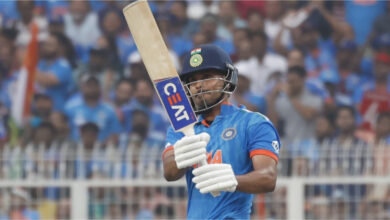Harmanpreet Kaur, Smriti Mandhana and the art of hitting in women’s cricket

As Harmanpreet Kaur demonstrated during her 143 against England, a combination of fluid bat-swing and finishing the shot has elevated batting in women’s cricket in recent years
It was a mishit really, off the fifth ball she faced on Wednesday evening against England, but it said much about Harmanpreet Kaur’s bat-swing, the soul of her batting. It was a gentle length delivery from the left-armer Freya Kemp – who would cop it from Harmanpreet in the end overs – and it seemed a regulation push, but her hands got away from her, as if on a mind of their own; she just about checked it and looked up with a touch of concern but even that handcuffed flow had chipped the ball over the mid-on fielder for a couple of runs.
Not many swing it like Harmanpreet Kaur. Catch the highlights of her mayhem at the end of the knock. She doesn’t carve over off; she fluidly scoops. She doesn’t heave to leg; she swings them. One of Indian cricket’s big hitters of yesteryears Salim Durani has a lovely verb to detail his sixes. “I lifted him for a six, I lifted him over long-on and such …”; Salim bhai never uses ‘hit’. Harmanpreet can proudly use the same lingo.
But the larger picture here, beyond Harmanpreet, in women’s cricket in the past decade or so is this evolution in the bat-swing. In the 80’s, the batting of the Indians and overseas batters was marked the absence of a fluidity in the bat-swing. As if the majority would react after the ball lands to do their thing, yanking, dragging, heaving at the last instant. There were exceptions of course but it’s the norm that one is interested in. The lack of bowling speed and quality of fielding were understandable but this bat-swing would irk. No longer, of course.
Highlights from the second ODI as India seal the series in Canterbury.
🏴 #ENGvIND 🇮🇳 pic.twitter.com/EkEBrGzmNT
— England Cricket (@englandcricket) September 22, 2022
Healy and Sciver
Check the top three ranked women ODI batters. Let’s consider two of them: Australia’s Alyssa Healy and England’s Nat Sciver. Healy pounces on the ball in much the same way Ricky Ponting would; not in style of the shots but in the game-sense, in her busy-ness.
And is there any other top-order batter who hits the ball as hard as Sciver? It’s one thing to fuel the big aerial hits with power, but Sciver seems to pack the traditional ground shots with more power than most; she does really ‘crunch’ her drives. As an aside, Sciver has the ‘Natmeg’ shot too, where she ever-so coolly nutmegs yorkers between her legs.
A common thing about all these batters – and one can include Smriti Mandhana, who hit a gorgeous 91 in the first ODI against England – is the fluidity in the bat-swing and how they seem to actually prep up for it, before the ball.
Staying with the shot
Second factor is how they stay with the shot, finish it, not get ahead of themselves, be it with the thought of running between the wickets or whatever. We often see it in the amateur cricket that we play; the real dadas finish the shot; the rest of us would hit it and are already trying to scramble across. Once Suresh Raina learnt to stay with his shots, finish them (think of his aerial punch over covers off seamers), his white-ball cricket took off to another level.
A combination of these two elements – the bat-swing and staying with the shot to its sweet end – has elevated batting in women’s cricket in recent years.
Watch Alyssa Healy next time she bats. When the spinners are on, she more often than not has her bat grounded in the stance. Against the seamers though, she has it up and ready, wa-high, and actually does a pendulum swing of sorts with the bat – a mock drill for the real one as a prep. Former Australia batter and coach Greg Chappell is a great believer of the pendulum swing and used to often talk about it. He was against cocking the hand too early and getting the bat up too early as it inhibits the free flow and also disrupts the defense, in case a batter has to block. Alyssa’s focus seems to be on that bat-swing pretty early in the piece.
As does Sciver, who regardless of pace or spin, gets her bat into that pre-shot pendulum loop, if anything with greater vigour, and probably why she manages to ‘crunch’ her drives real hard.
And all of them stay with the shot all the way till the post-impact extension is fully done.
Mandhana’s strong top-hand
Let’s cue up an extra cover drive from Mandhana during her 91, when she was on 10. Issy Wong with a length ball and not much pace too to work with (111kmph), but Mandhana doesn’t over-hit it. Stretches well forward and just caresses it, staying with the shot – and the push-drive has the ball plummeting between extra cover and mid-off.
Harmanpreet even practises with an actual golf driver before any knocking at nets. “She uses the golf-swing simulation for hip-shoulder dissociation. It’s her own unique thing,” the India physio Anand Date had told this newspaper during the Commonwealth Games. “Harman has a natural swing, and it helps her get into rhythm.”
It’s in the follow-through arc the bat cuts that her batting fluidity screams out all that more. She finishes the shot, with her bat traversing all the way up and over and behind her shoulders. She doesn’t hold back at all. It’s most pronounced when she is in her attacking phase as she was near the end of her hundred on Wednesday. Then there is no doubt, no hesitancy in holding back, she tries to pick length early and lets the bat-swing go through unimpeded.
🚨 MILESTONE ALERT 🚨
Smriti Mandhana becomes the fastest 🇮🇳 woman cricketer to complete 3️⃣0️⃣0️⃣0️⃣ runs in ODI cricket 🙌
The undisputed 👑 for a reason 👊#ENGvIND #SmritiMandhana pic.twitter.com/XG6iHh4QOW
— SunRisers Hyderabad (@SunRisers) September 21, 2022
Mandhana is nonchalantly imperious in her lofted shots to the seamers. Like Sourav Ganguly, the batter she at times resembles, she was a natural right-hander who converted to a left-handed batter. In her elder brother’s telling it was because she used his old left-handed gloves when she took up the game and in her account, it’s because their father had a thing for left-handers.
It’s easy to see why her top hand is the stronger one. There is a theory going around in cricket that people have got the batting grip all wrong — traditionally, the top hand is the weaker for the right-handed batters and most grip the bat more strongly in their bottom hand, their natural hand.
The theory is that the top hand should be firmer and the bottom hand looser. You can see that in Mandhana. She can go through the line of the ball, sending it up and over mid-off rather nonchalantly.
Finishing the shot, fluidity in the bat-swing, even prepping for it in stance, weren’t commonplace in women’s cricket in the dant past. No longer, though. It’s crash, bang, wallop time – all skilfully woven together.







